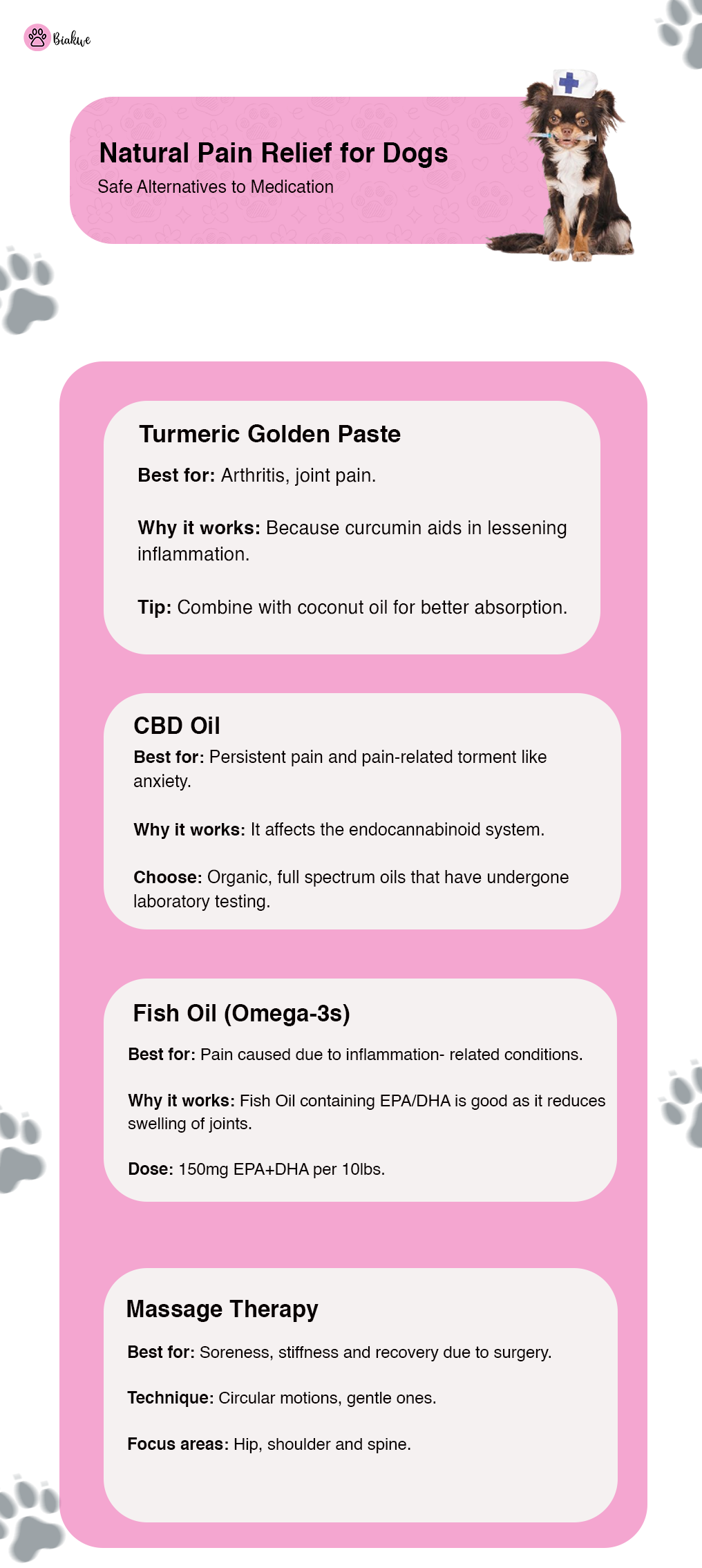The first thought that crosses your mind when you see your dog limping or whimpering is “what can I give my dog for pain?” While some human painkillers can be unsafe for your pet, there are various natural remedies that can be used.
Dr. Karen Becker comments:
“‘Nature has provided and made available a variety of effective pain relievers that work synergistically with your dog’s ecosystem, rather than against it.”
This guide discusses:
- Effective painkillers for dogs
- Knowing when veterinarians are necessary
- Other urgent attention to take care of pain
- Solutions in nature’s form over a long time
Now let’s learn the best methods of remedying your pup’s pain.
Indications That Your Dog is Experiencing Pain
Symptoms associated with “what to give dogs for pain” should be thought through carefully:

Typical indicators of pain include
- Limping or stiffness
- Whining or excessive licking
- Loss of appetite
- Aggression when touched
- Heavy panting at rest
If you’re considering “my dog is in pain, what can I give”, evaluate the situation first. Trauma and sudden collapse require immediate vet attention.
Pain relief for dogs ensures your pup stays happy and active, but pet health matters for all furry friends. Explore natural cat hairball remedies to keep your feline comfortable. Learn how holistic care benefits both dogs and cats for a thriving pet household!
Human Medicines That Are Extremely Dangerous To Pets
Pet owners usually wonder, what painkiller can I give my dog, however, a human painkiller can be deadly for your furry friends.
Medicines Not to Give Pets
- Ibuprofen (Advil): Causes Kidneys to Shut Down.
- Acetaminophen (Tylenol): Toxic Towards Liver.
- Aspirin: Safe, only if prescribed by a vet.
Dr. Judy said it best:
“One pill can kill. Always consult your vet first.”
Top 7 Natural Pain Relief for Dogs
Now, let us explore the subject of “what can I give my dog for immediate pain relief?”

Turmeric Golden Paste
- Best for: Arthritis, joint pain.
- Why it works: Because curcumin aids in lessening inflammation.
- Tip: Combine with coconut oil for better absorption.
- Dose: 1/8 tsp per 10 pounds each day.
CBD Oil
- Best for: Persistent pain and pain-related torment like anxiety.
- Why it works: It affects the endocannabinoid system.
- Choose: Organic, full spectrum oils that have undergone laboratory testing.
- Dose: 1-2 mg per 10 lbs twice daily.
Fish Oil (Omega-3s)
- Best for: Pain caused due to inflammation- related conditions.
- Why it works: Fish Oil containing EPA/DHA is good as it reduces swelling of joints.
- Dose: 150mg EPA+DHA per 10lbs.
Ginger
- Best for: Alleviating muscle soreness and pain caused due to nausea.
- Why it works: Due to the presence of gingerols, pain pathways are blocked.
- Dose: 1/4 tsp grated root/20 lbs.
Massage Therapy
- Best for: Soreness, stiffness and recovery due to surgery.
- Technique: Circular motions, gentle ones.
- Focus areas: Hip, shoulder and spine.
Acupuncture
- Best for: Injury-related nerve pain as well as issues with movement.
- How it helps: Pain-killing mechanisms can be activated.
- Recommended sessions: Once a week for maximum effect.
Cold and hot therapy
- Best for: Sudden acute injuries done to any part of the body.
- Cold packs: Help lessen the swelling, should be used for 20 minutes with breaks in between.
- Warm compresses: Help reduce stiffness, should be used for 10-15 minutes only.
Pain relief for dogs helps your canine companion live their best life. Curious about caring for other pets? Discover Siamese cat breeds, known for their vocal charm. Learn how tailored health solutions keep both dogs and cats vibrant and pain-free!
Emergency Pain Relief: Immediate Response Measures
When thinking “my dog is in pain, what can I give immediately?”, your first thoughts go to the most accessible solutions:

Effective Solutions
- Cold compress: For inflamed joints, ice packs wrapped in towels can be applied in 10-minute intervals.
- Supine Positioning: Prop the injured segments with pillows to ease the arms/legs.
- Nourishment restricts: Lower water intake but adds bone broth to enhance drinking.
- Stress reduction: Wipe out light and any source of sound.
Vet nurse Sarah Williams recommends:
“For acute injuries, restrict movement and call the vet while still providing primary first aid.”
When Natural Options Aren’t Sufficient
Although pondering over “what can I give my dog for immediate pain relief” is understandable, some scenarios require veterinary prescribed analgesics for canines.
Seek Emergency Care if:
- Your dog can’t stand up
- Pain lasts more than 48 hours
- You notice bleeding or broken bones
- They refuse food for 24+ hours
Pain Management Over a Period of Time
Some conditions like arthritis require more than an occasional relief strategy, like “what can you give a dog for pain” style medicine.

Comprehensive Methods
- Control of body weight: Additional weight increases 4x stress on joints for every single pound over the limit.
- Gentle exercise: Swimming accomplishes less stress on hips.
- Orthopedic beds: Memory foam aids in achy joint support.
- Physical therapy can increase mobility by 40% over 8 weeks.
Best tip: Make sure to include it with black pepper to make turmeric absorption come out at 2000%.
Conclusion
If you’re searching for options in regard to “what can I give my dog for pain?” It shows you care for your pet. For milder symptoms, natural methods may suffice, but stubborn pain always requires veterinary attention. Therapeutic combinations tend to work best, for example, long-term joint relief can be managed with fish oil, while days requiring more hands-on relief can be addressed with massage.
Remember: Your dog’s whimper is a way of communicating to you their discomfort, thus it is your responsibility to act sensibly. Professional treatment is far superior to at-home treatment options whenever in doubt.
For more information visit Biakwe.
